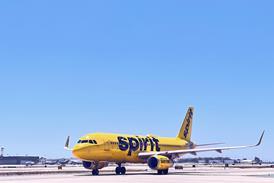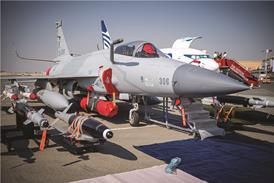Ramon Lopez/WASHINGTON DC
The US government's unexpected opposition to Lockheed Martin's planned $12 billion acquisition of Northrop Grumman led to the deal's demise, but the so-called "merger mania" evident since the end of the Cold War is now expected to produce a wave of consolidation among smaller, second-tier US defence and aerospace firms as they seek the critical mass needed to survive. Most aerospace analysts believe that Lockheed Martin will pause to lick its wounds.
Credit Suisse First Boston analyst Peter Aseritis expects that Lockheed Martin will "-sit tight and look inward. I'd be surprised if we see an acquisition over the next year or so." He believes that the big US defence contractor will focus on current problems, such as the Theater High Altitude Area Defense anti-ballistic-missile project. Technical problems have dogged the $15 billion programme so far.
Paul Nisbet, aerospace analyst at JSA Research, believes Lockheed Martin is no longer in a buying mode, and could instead sell off some smaller non-core assets such as the commercial electronic products of Sanders.
Northrop Grumman, on the other hand, is seen taking the opposite tack as it seeks to grow its defence electronics businesses. Kent Kresa, chairman, president and chief executive, has said that the company's future "-is not dependent on any merger. Lockheed Martin came to us. We were not shopping the company.
"We entered into the merger in the strongest position in our history and, if anything, we are stronger today. We not only intend to survive - we expect to strive. Our focus is on organic growth as well as targeted acquisitions in defence electronics, information technology and commercial aerostructures."
Industry analysts say the company can probably remain an independent company, although it might have to revamp its business strategy. Only a month after the merger with Lockheed Martin collapsed, Northrop Grumman signed an agreement to acquire Inter-National Research Institute (INRI) for $55 million.
INRI, which expects $60 million in revenues this year, is a private software company specialising in command and control, tracking, data fusion and mapping for the US Department of Defense. Kresa says that the deal will enable Northrop Grumman to broaden its presence in the command and control, battle management and information technology marketplaces.
INRI will be folded into Logicon, which was itself acquired by Northrop Grumman last year as part of a strategy to double the company's information technology business, to around $2 billion, by 2002. Meanwhile, speculation is growing that Northrop Grumman is seeking to build up its portfolio by acquiring the defence electronics operations of GTE, which is attempting to push through a giant telecommunications merger. Counter offers could come from GEC-Marconi, General Dynamics and Lockheed Martin.
Aseritis sees a rocky road ahead for Northrop Grumman. "[The company's] balance sheet is not overly strong. Stock prices plummeted after the merger was called off, and the firm is without a full quiver of arrows," he says.
In seeking Northrop Grumman, Lockheed Martin was moving to counter Boeing's merger with McDonnell Douglas and Raytheon's acquisitions of the defence businesses of Hughes Aircraft and Texas Instruments.
In July, Raytheon elected to strengthen its command, control and communications product line with the $63 million acquisition of the Baltimore, Maryland-based unit of AlliedSignal, which produces identification friend-or-foe systems as well as civil and military air traffic control equipment.
AlliedSignal did not consider secure military communications a core business, unlike aircraft powerplants, subsystems, avionics and automobile parts. The company, meanwhile, has initiated a $10 billion hostile take-over of AMP, which makes electronic connectors.
The acquisition would mean a fundamental change to AlliedSignal's business portfolio. Nisbet says that the company would probably need to sell off the rest of its automobile operations to pay for AMP. He would have preferred seeing a bid for Northrop Grumman.
Meanwhile, Raytheon agreed to sell portions of its electro-optical and focal plane array sensor businesses to DRS Technologies for an undisclosed amount of cash. The divestiture was a condition of the deals for the defence units of Hughes Aircraft and Texas Instruments.
Nisbet believes that Raytheon "-is set for a while", but an unknown quantity is Daniel Burnham, who was in charge of AlliedSignal's aerospace businesses before becoming Raytheon's chief executive on 1 July.
The main focus of the consolidation trend in the US defence industry has shifted to the second tier of suppliers. For example, Litton Industries agreed in August to sell its Solid State division to the UK's Filtronic for $43 million. Litton is also making selective acquisitions, including its December 1997 purchase of TASC, an information technology specialist, for $432 million.
flush with cash
General Dynamics, meanwhile, is flush with cash and continues to make acquisitions, focusing primarily on defence electronics. Aseritis wonders whether the strategy makes sense. He says that the company can only hope to trail Boeing, Lockheed Martin, Northrop Grumman and Raytheon.
In June, the UK's GEC completed its $1.4 million acquisition of Tracor, a US manufacturer of mission planners, airborne electronic warning systems and countermeasures, and aerial targets. GEC also offered to buy parts of Lockheed Martin and Northrop Grumman to help the merger through anti-trust scrutiny, an offer now redundant.
Source: Flight International























